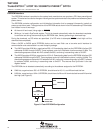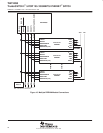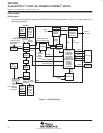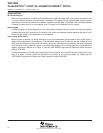
TNETX4090
ThunderSWITCH II
9-PORT 100-/1000-MBIT/S ETHERNET
SWITCH
SPWS044E – DECEMBER 1997 – REVISED AUGUST 1999
44
POST OFFICE BOX 655303 • DALLAS, TEXAS 75265
compatibility with future device revisions
All EEPROM locations that correspond to reserved addresses in the memory map, register bits that are read
only, and register bits that are marked as reserved should be set to 0 to ensure compatibility with future versions
of the device. Failure to do so may result in the unintentional activation of features in future devices. All such
bits are included in the CRC calculation.
LED interface
This interface allows a visual status for each port to be displayed. In addition, the state of the internal flow control
and fault functions are displayed along with 12 software-controllable LEDs.
Each port has a single LED that can convey three states, as shown in Table 15.
Table 15. Port LED States
STATE DISPLAY
No link Off
Link, but no activity On
Activity Flashing at 8 Hz
Port 08 has an additional LED, C08, to indicate the occurrence of a collision when operating in PMA mode; this
LED also has three states, as shown in Table 16.
Table 16. Collision LED States
STATE DISPLAY
No collision (or non PMA mode) Off
Occasional collision On
Frequent collisions Flashing at 8 Hz
The interface is intended for use in conjunction with external octal shift registers, clocked with LED_CLK. Every
1/16th of a second, the status bits are shifted out via LED_DATA.
The status bits are shifted out in one of two possible orders, as determined by slast in LEDControl, to ensure
that systems that do not require all the LED status can be implemented with the minimum number of octal shift
registers.
If slast = 0, the software-controlled status bits are shifted out before the port status bits.
If slast = 1, the software-controlled status bits are shifted out after the port status bits.
The fault status bit is shifted out last, enabling a minimal system that displays only the fault status to be
implemented without any shift registers.


















